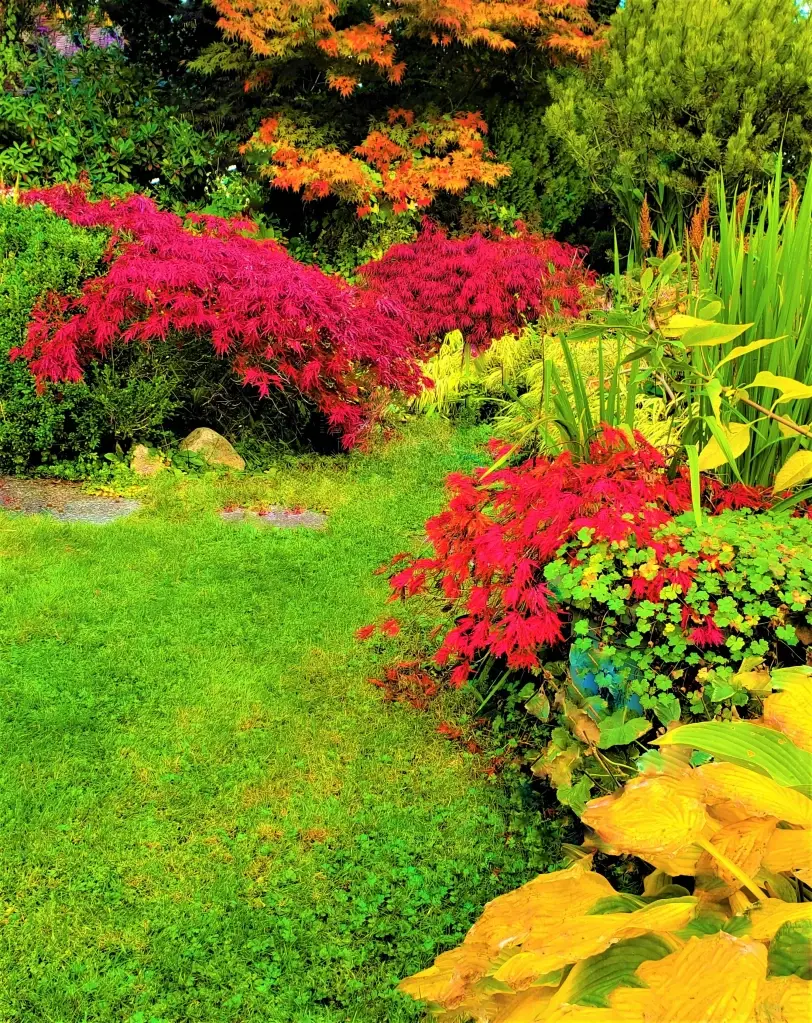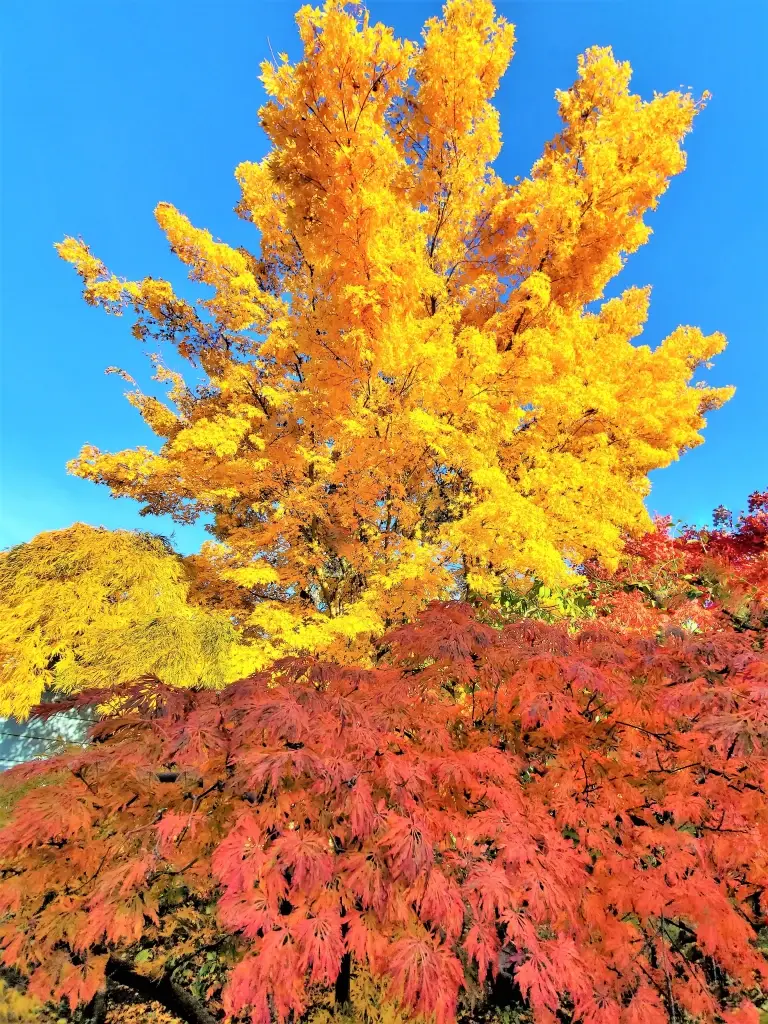Finding Beauty in Fall Foliage
- vendiolaads
- Nov 5, 2022
- 5 min read
Beauty, as some people say, is in the eye of the beholder. Great beauty can be seen all around us if we put on our appreciative lenses. Colorful beauty is all around our neighborhood this time of the year, the start of Autumn. It's when the Fall foliage is at its best. Crimson and Valentiny reds, Halloweeny oranges, brilliant golds, and radiant yellows. This time of the year, the main attractions of our gardens and the neighborhood landscapes are the fall foliage.

Fall foliage takes the centerstage from the flowers of spring and summer. Flowers only bloom for a few weeks while the foliage is there for most of the year – evergreens even keep their foliage whole year round – so paying due attention to the appearance and other characteristics of the leaves of our garden plants gains priority.
And so in this blog, I’ll focus on FALL foliage colors. For most people, Fall signifies the downhill slide in the garden. But for us, we see Fall as the bursting of vibrant colors and a thanksgiving of a good year of joyful gardening.

Let Nature be the great teacher. Seasons, for example, have an unmistakable way of showing us lessons on how to create a good garden. Fall pushes us to focus on foliage colors, shapes, sizes and textures. That, as much as we give due diligence in choosing our garden plants in spring and in summer based on flower colors, shapes, fragrance, form, and size. May I add price.
Like it or not, fall forces us to recognize foliage as one key element in our garden. Fall is much about foliage colors. After all, very few flowers are to be found in the thick of Fall.

Fall also gives us the need to appreciate how important evergreens are in our garden as the rest of the plant kingdom loses its leaves. Green becomes a refreshing, promising sight when
the rest of the vegetation is dead brown or blackened.
When snow comes around in late Fall, or in winter, to blanket the landscape, we then also recognize the importance of the shapes of plants. Even the shapes of their branches, dead flowers, and seed heads.
Luckily, in the place where we live, along or close to the ocean, the warm Pacific breeze keeps our local climate balmy and blows the snow away towards the interior and the higher elevation of the continent.

So, the white fluffy stuff seldom visits us. If it does, the visit is much shorter and much later in the year. But we do have our share of snowstorms now and then when the Arctic air prevails over the Pacific breeze.
Snow creates some displays on the surfaces of what’s left in our garden. A flat white sheet in a garden is easy to look at but hardly interesting. Interest comes from various shapes and sizes and heights shimmering in powdery white.
For this reason, we leave the dead flowers and seed heads of specific perennials in case we get snow. The dead and dried flower balls of allium that look like Sputniks, and fennel and the stand of dead sedums can create very eye-catching forms once blanketed by snow. They’re actually mesmerizing. Amazing work of art by Nature.

Enough about snow. Back to Fall foliage.
Fall = foliage in reds, oranges, yellows, and of course greens.

Japanese gardens, notably, are sanctuaries of peace, simplicity, and order, yet when Fall comes these gardens explode in riots of colors. The Japanese maples, and other trees and shrubs, in Japanese gardens now display amazing color ranges of orange, red, and yellow. These colors contrast beautifully with the greens of mosses, ferns, and evergreens as well as the browns of tree trunks, branches, and twigs.
As the plethora of colors gets reflected on the surfaces of the water, which is a key element in Japanese gardens, the wow factor jumps several notches up. We have much to learn from the Japanese on exploiting foliage colors and form.
So, in our home garden, we allocate spaces to plant Japanese maples. We prefer the burgundy-leaved varieties (Acer palmatum atropurpureum Bloodgood).

The Japanese maples anchor many of our plantings. Having more of one type of anchor plant avoids chaos and instead creates a cohesive look in our small home garden. When dressed in their Fall colorful splendor, the Japanese maples appear to be giant colorful floral displays more than merely deciduous plants doing their Swan Lake number before their last leaf clings to the bough.
A weeping dwarf Japanese maple, for example, squats at the axis of our street-side berm. Two other weeping dwarfs act as bookends to our clipped boxwood border along our front walkway.
A medium-height variety of the Japanese maple each presides over variegated boxwood that forms semicircular “bumps” on our double S-shaped (S as in Sansen, touche) borders that are running alongside the street side of our house.

Taller varieties of the Japanese maple grow underneath our next-door neighbor’s giant, old pine trees. We also planted two Japanese maple trees (Acer palmatum dissectum Viridis) that have light green lacy leaves during summer but turn fruity orange in early Fall.
The lacy deep-cut leaves of Acer palmatum dissectum Viridis change from pale green to bright orange in Fall, making this variety such great specimen shrubs
With these many Japanese maple trees our intimate home garden in Fall still looks very colorful even when devoid of flowers.

Our deciduous perennials contribute golden and yellow foliage to the display, too, before their leaves fall off. The evergreens provide various shades of green. So while our garden is a semi-formal English garden in summer, it has a semblance of a Japanese garden in Fall. Our few visits to Japanese gardens have paid off.
We make sure to incorporate a few plants to give us other foliage colors. Ninebark Diablo and heucheras are pretty in purple.
The chartreuse Lady’s mantle (Alchemilla mollis) tucked at various edges of the front and side garden are easy companion plants to most of our border plants. The fuzzy cup-like
leaves of the Lady’s mantle catch droplets of water that look like glistening glass beads floating on the chartreuse leaves.
Sedums (Sedum spectabile Autumn Joy) bloom in late Summer/early Fall, first as a bright chartreuse broccoli-like flower buds that open to pink tiny flowers in a big bunch then finally rusty brown. We don’t cut its dead flower heads perchance we have snow in Winter. Sedum catches the snow on those dead flower heads that transform into magical form that reminds us of cotton candy.
Some outstanding garden plants reward us with beautiful autumn berries, fruits, seeds and seed pods in the fall. We don’t neglect to include some of these in our garden. We try to have plenty of interest outdoors as well as material for beautiful fall arrangements.
The many white-variegated and the cream-edged boxwood that we shape into giant orbs
along the S-shaped house borders provide splotches of whites and creams and chartreuse.

Years back we shaped that variegated boxwood into big round balls on de-leafed branches so they mimic the portals of dear old Silliman U, our alma mater. As they slowly bulk up, bigger and taller — and as we tire out of shaping them into Silliman Portals — they’re now looking like giant green beach balls rolling after each other in our street-side border. They still look attractive, I think.
We rely on the greens of our pine topiaries, cedar hedges, and the greens of most leaves of the perennials to harmonize all these bright colors of the foliage plus those of the hundreds of blooms during the flowering seasons and into the Fall. We also plant together perennials with similar or complementary colors to avoid over-used razzmatazz of color palettes. We notice too many colors in our garden can be eye-catching up front but can create a messy look over time. Also, using large numbers of the same or similar plants cuts down on maintenance as well as makes caring for growth and flowering less complicated. With a controlled color scheme, our garden looks simplified (not boring) but layered and still attractive and dramatic. For true and enduring beauty in the garden, we learn LESS IS MORE.





Comments